The bilingual site devoted to the cultural life in Sri Lanka and in France
 |
||||||||

H O M E / I N B R I E F ACTUALITE CULTURE DOSSIERS SOCIETE GALERIE A suivre...
Through these notes on a journey to Ceylon I did in January-February 1897, I would like to encourage tourists and artists to go and see this unique and marvellous country, which presents all the beauties of a tropical country without any health inconvenience encountered in most of the tropical regions.
It is, indeed, a very convenient and easy journey which does not determine any privation ; I did it with a friend who found the trip very good and she is always prepared to go there again ; moreover, it is not an expensive journey, mainly for a woman, who can save the money usually allocated to winter dresses.
For those who are more adventurous, not afraid of bout of fever, mosquito-bites and thousands of troubles which occur when setting up camps in the jungle, it is possible, without leaving Ceylon, to give oneself safaris into a new and difficult country, elephant or panther or bear hunting, and interesting visits to some almost unknown ruins.
On the spot, in Colombo, it will be easy to find whatever is needed. Everything, in Colombo, is cheaper than in France, and more adjusted to the climate, except maybe for shoes ; it is better to bring them, particularly if you dont'have an English foot. To be continued...
André Maire, peintre voyageur... André Maire

Sri Lanka / France
![]()
Cinéma
![]()
Danse
![]()
Exposition
![]()
Littérature
![]()
Musique
![]()
Patrimoine
![]()
Photographie
![]()
Poésie
![]()
Spiritualité
![]()
Paul Cézanne
![]()
Fascination du Corps
![]()
La lumière de Gauguin![]()
Jean de La Fontaine
![]()
Malraux / Segalen
![]()
Mondialisation
![]()
Picasso-Rodin
![]()
Pigeonniers du Quercy
![]()
Raphael
![]()
Saint-Exupéry
![]()
Avortement
![]()
Peine de Mort (en anglais)
![]()
Santé Mentale
![]()
SIDA
![]()
Raphaël
![]()
Miniatures de Kangra
![]()
Emile Bruyas
Two Months in Ceylon, Lyon, 1898.
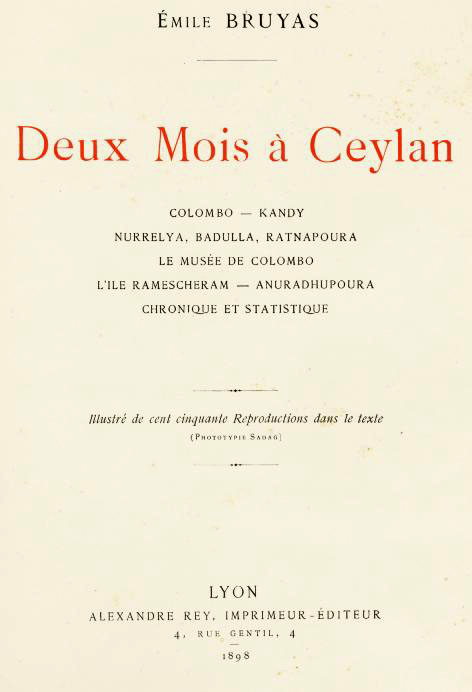
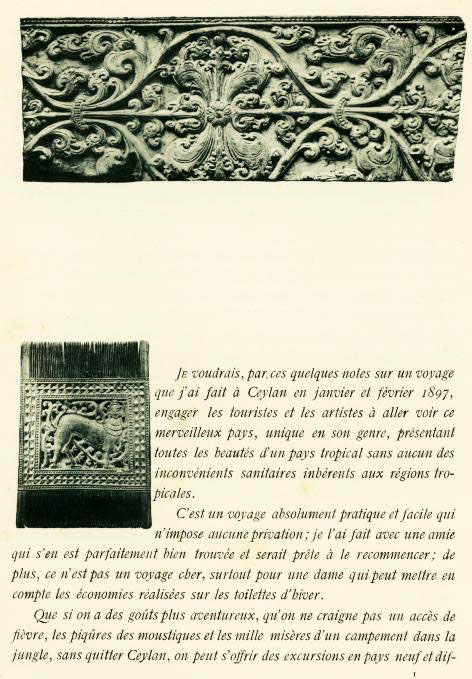
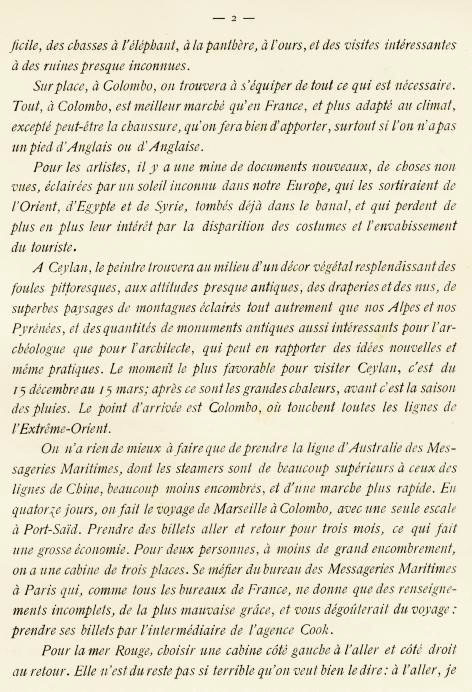
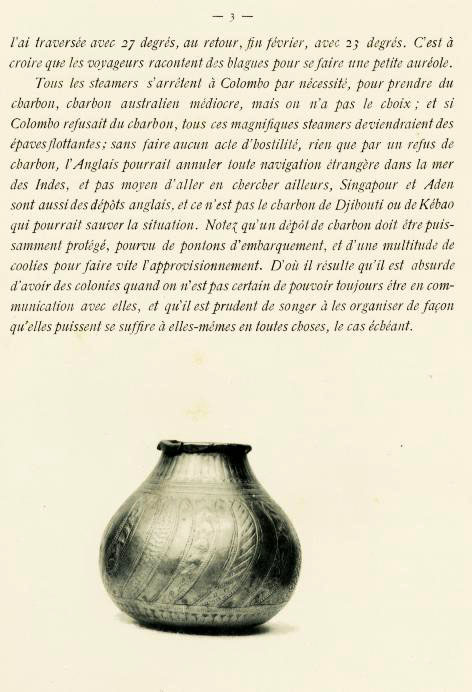
Artists will discover plenty of new documents, never seen things, with the light of a sun which is unknown in our Europe ; they should go out the East, Egypt and Syria which are now becoming common, and loosing their interest as a result of the disappearance of customs and the invasion of tourists.
In Ceylon, in the middle of a radiant vegetation, the painter will find colourful crowds, with some ancient attitudes, draperies and nudes, beautiful landscapes of mountains of which the light is different from our Alpes or Pyrénées, and a lot of ancient monuments with an archeological and architectural interest, since it is possible to bring back some new and even practical ideas. The most favourable period for a visit to Ceylon is from the 15th December to the 15th March ; afterwards, it is the hot season ; earlier, the rainy season. The arrival for all lines to the Far East is in Colombo.
The best solution is to use the line for Australia by the "Messageries Maritimes" ; their steamers are superior to the steamers which are desserving China, they are also less crowded and faster. Fourteen days are needed to do the journey Marseille - Colombo, only calling one time at Port-Said. Please take return ticket for three months, it is a big economy. Unless overcrowding, two persons can share a three places cabin. Be careful with the Office of Messageries Maritimes in Paris ; like all offices in france, it only gives, grudgingly, uncomplete information which put you off doing the journey : take your tickets through the agence Cook.
For Red Sea, a left side cabin will be chosen - right side for the return. This is not so terrible : on the way, I went accross with 27 degrees, on the return, at the end of February, with 23 degrees. It would seen that travellers tell stories to get some glory.
All steamers stop out of necessity in Colombo, in order to take coal, which is a poor quality Australian coal, since there is no choice ; and if Colombo refused to deliver coal, all these beautiful steamers would become flotting wercks ; without showing any hostile behaviour, only through a refusal of coal, English should cancel any foreign navigation in the Indian Sea, and nothing to do elsewhere, since Singapore and Aden are also English depots, and the situation should not be saved by the coal of Djibouti or Kebao. It should be noted that a coal depot has to be strongly protected, equipped with landing stages, and a lot of coolies in order to provide supplies quickly. As a result of all this, it is absurd to possess colonies without the certainty of communications with them, and it is wise, if need be, to organize them in a self-sufficient mannner.
Dessins d'Afrique et d'Asie
|
Exposition présentée récemment au "Musée des Années 30" 28, avenue André Morizet 92100 - Boulogne Billancourt Tél : 00 33 1 55 18 46 42 André Maire (1898-1984), grand peintre voyageur des années 30, a parcouru le monde et en a laissé un spectaculaire livre d'images où l'imaginaire sublime toujours la simple réalité. De ses itinéraires en Afrique et en Asie, quelque 140 dessins retracent son rêve d'Orient. L'exposition présentait une soixantaine de grands formats, essentiellement des sanguines et des sépias. | 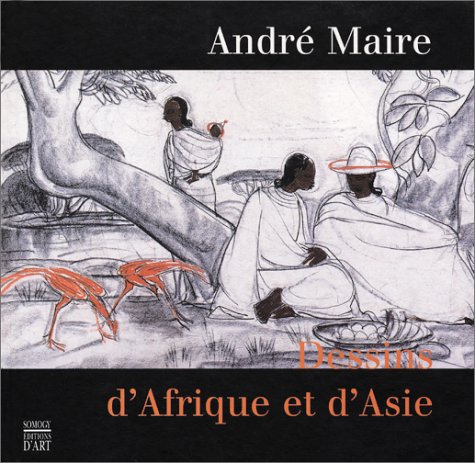 |
Les voyages d'André Maire
Accompagnant la parution de l'ouvrage "André Maire, peintre voyageur", le Musée d'Art Moderne de Troyes a présenté récemment une exposition des oeuvres de ce grand peintre.
André Maire a cette particularité qui fit sa renommée de s'inspirer du style et des tons propres à chacun des pays qu'il a visité tout au long de sa vie. Indochine, Italie, Espagne, Egypte, Indes, Ceylan, Afrique, Madagascar... autant de lieux à la culture caractéristique, aux noms qui laissent rêveur et dont André Maire a su s'imprégner pour nous faire voyager sans quitter la salle d'exposition.
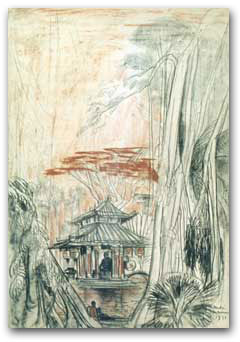 |
André Maire est un personnage au parcours atypique, qui n'a fait aucune école, n'a fait partie d'aucun courant. C'est seul, avec les conseils d'Emile Bernard - dont il fut l'élève - qu'il développe son propre style, se libérant de toutes influences. La construction de son style et de ce qui lui valut le succès qu'il a remporté tire ses origines de la découverte, entre 1919 et 1921, d'Ankhor, cette "voie royale" qu'André Malraux évoquera dix ans plus tard. Pour lui, l'aventure, avec sa part de découverte, celle de la jungle et des grands temples khmers, fut aussi une méditation sur l'art et la mort.
En outre, de ses voyages et de ce dernier plus particulièrement, André Maire rapporta une coloration particulière, teintée de tons chauds qu'il parvint à matérialiser par l'utilisation de la sépia.
|
La marque André Maire
Grand dessinateur, André Maire était également un excellent paysagiste, révélant dans ses oeuvres l'aspect imaginaire des lieux qu'il visitait, tout en en conservant la réalité.André Maire livre une oeuvre foisonnante, solide, construite, évolutive, passant de la monochromie aux couleurs les plus vives. Ses nus, paysages, natures mortes et portraits, ainsi que ses grandes fresques décoratives en font un peintre important des années trente.
